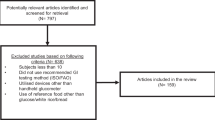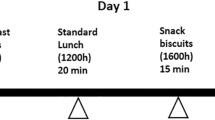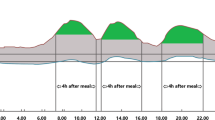Abstract
Objective: Practical use of the glycaemic index (GI), as recommended by the FAO/WHO, requires an evaluation of the recommended method. Our purpose was to determine the magnitude and sources of variation of the GI values obtained by experienced investigators in different international centres.
Design: GI values of four centrally provided foods (instant potato, rice, spaghetti and barley) and locally obtained white bread were determined in 8–12 subjects in each of seven centres using the method recommended by FAO/WHO. Data analysis was performed centrally.
Setting: University departments of nutrition.
Subjects: Healthy subjects (28 male, 40 female) were studied.
Results: The GI values of the five foods did not vary significantly in different centres nor was there a significant centre×food interaction. Within-subject variation from two centres using venous blood was twice that from five centres using capillary blood. The s.d. of centre mean GI values was reduced from 10.6 (range 6.8–12.8) to 9.0 (range 4.8–12.6) by excluding venous blood data. GI values were not significantly related to differences in method of glucose measurement or subject characteristics (age, sex, BMI, ethnicity or absolute glycaemic response). GI values for locally obtained bread were no more variable than those for centrally provided foods.
Conclusions: The GI values of foods are more precisely determined using capillary than venous blood sampling, with mean between-laboratory s.d. of approximately 9.0. Finding ways to reduce within-subject variation of glycaemic responses may be the most effective strategy to improve the precision of measurement of GI values.
This is a preview of subscription content, access via your institution
Access options
Subscribe to this journal
Receive 12 print issues and online access
$259.00 per year
only $21.58 per issue
Buy this article
- Purchase on Springer Link
- Instant access to full article PDF
Prices may be subject to local taxes which are calculated during checkout




Similar content being viewed by others
References
Abdallah, L, Chabert, M & Louis-Sylvestre, (1997). Cephalic phase responses to sweet taste. Am. J. Clin. Nutr., 65, 737–743.
Åkerberg, A, Liljeberg, H & Björck, I (1998). An in vitro method based on chewing, to predict resistant starch content in foods allows parallel determination of potentially available starch and dietary fiber. J. Nutr., 128, 651–660.
Allison, DB, Paultre, F, Goran, MI, Poehlman, ET & Heynsfield, SB (1995). Statistical considerations regarding the use of ratios to adjust data. Int. J. Obes. Relat. Metab. Disord., 19, 644–652.
AOAC (1995). Official Methods of Analysis, 16th edn. Arlington, VA: Association of Official Analytical Chemists
Björck, I, Granfeldt, Y, Liljeberg, H, Tovar, J & Asp, N-G (1994). Food properties affecting the digestion and absorption of carbohydrates. Am. J. Clin. Nutr., 59, (Suppl) 696S–705S.
Brand, JC, Colagiuri, S, Crossman, S, Allan, A, Roberts, DCK & Truswell, AS (1991). Low-glycemic index foods improve long-term glycemic control in NIDDM. Diabetes Care, 14, 95–101.
Brand-Miller, J, Foster-Powell, K & Colagiuri, S (1996). The GI Factor, Hodder: Sydney
Coppack, SW, Fisher, RM, Gibbons, GF, Humphreys, SM, McDonough, MJ, Potts, JL & Frayn, KN (1990). Postprandial substrate deposition in human forearm and adipose tissue in vivo. Clin. Sci., 79, 339–348.
Englyst, HN, Kingman, SM & Cummings, JH (1992). Classification and measurement of nutritionally important starch fractions. Eur. J. Clin. Nutr., 46, S33–S50.
FAO/WHO (1998). Carbohydrates in Human Nutrition, FAO Food and Nutrition Paper 66 Rome: FAO
Foster-Powell, K & Brand-Miller, J (1995). International tables of glycemic index. Am. J. Clin. Nutr., 62, 871S–893S.
Frost, G, Wilding, J & Beecham, J (1994). Dietary advice based on the glycaemic index improves dietary profile and metabolic control in type 2 diabetic patients. Diabetic Med., 11, 397–401.
Frost, G, Leeds, A, Trew, G, Margara, R & Dornhorst, A (1998). Insulin sensitivity in women at risk of coronary heart disease and the effect of a low glycemic diet. Metabolism, 47, 1245–1251.
Frost, G, Leeds, AA, Doré, CJ, Madeiros, S, Brading, S & Dornhorst, A (1999). Glycaemic index as a determinant of serum HDL-cholesterol concentration. Lancet, 353, 1045–1048.
Gilbertson, HR, Brand-Miller, JC, Thorburn, AW, Evans, S, Chondros, P & Werther, GA (2001). The effect of flexible low glycemic index dietary advice vs measured carbohydrate exchange diets on glycemic control in children with type 1 diabetes. Diabetes Care, 24, 1137–1143.
Jackson, RA, Peters, N, Advani, U, Perry, G, Rogers, J, Brough, WH & Pilkington, TRE (1973). Forearm glucose uptake during the oral glucose tolerance test in normal subjects. Diabetes, 22, 442–458.
Järvi, AE, Karlström, BE, Granfeldt, YE, Björck, IE, Asp, N-G & Vessby, BOH (1999). Improved glycemic control and lipid profile and normalized fibrinolytic activity on a low-glycemic index diet in type 2 diabetic patients. Diabetes Care, 22, 10–18.
Jenkins, DJA, Wolever, TMS, Kalmusky, J, Guidici, S, Giordano, C, Patten, R, Wong, GS, Bird, JN, Hall, M, Buckley, G, Csima, A & Little, JA (1987a). Low-glycemic index diet in hyperlipidemia: use of traditional starchy foods. Am. J. Clin. Nutr., 46, 66–71.
Jenkins, DJA, Wolever, TMS, Collier, GR, Ocana, A, Rao, AV, Buckley, G, Lam, KY, Meyer, A & Thompson, LU (1987b). The metabolic effects of a low glycemic index diet. Am. J. Clin. Nutr., 46, 968–975.
Liu, S, Willett, WC, Stampfer, MJ, Hu, FB, Franz, M, Sampson, L, Hennekens, CH & Manson, JE (2000). A prospective study of dietary glycemic load, carbohydrate intake and risk of coronary heart disease in US women. Am. J. Clin. Nutr., 71, 1455–1461.
Matthews, DR, Lang, DA, Burnett, M & Turner, RC (1983). Control of pulsatile insulin secretion in man. Diabetologia, 24, 231–237.
Salmerón, J, Manson, JE, Stampfer, MJ, Colditz, GA, Wing, AL & Willett, WC (1997a). Dietary fiber, glycemic load, and risk on non-insulin-dependent diabetes mellitus in women. JAMA, 277, 472–477.
Salmerón, J, Ascherio, A, Rimm, EB, Colditz, GA, Spiegelman, D, Jenkins, DJ, Stampfer, MJ, Wing, AL & Willett, WC (1997b). Dietary fiber, glycemic load, and risk of NIDDM in men. Diabetes Care, 20, 545–550.
Soh, NL & Brand-Miller, J (1999). The glycaemic index of potatoes: the effect of variety, cooking method and maturity. Eur. J. Clin. Nutr., 53, 249–254.
Thomas, DE, Brotherhood, JR & Brand, JC (1991). Carbohydrate feeding before exercise: effect of glycemic index. Int. J. Sports Med., 12, 180–186.
Wolever, TMS (1992). Glycemic index vs glycemic response: non-synonymous terms. Diabetes Care, 15, 1436–1437.
Wolever, TMS & Bolognesi, C (1996). Source and amount of carbohydrate affect postprandial glucose and insulin in normal subjects. J. Nutr., 126, 2798–2806.
Wolever, TMS, Jenkins, DJA, Vuksan, V, Josse, RG, Wong, GS & Jenkins, AL (1990). Glycemic index of foods in individual subjects. Diabetes Care, 13, 126–132.
Wolever, TMS, Jenkins, DJA, Jenkins, AL & Josse, RG (1991). The glycemic index: methodology and clinical implications. Am. J. Clin. Nutr., 54, 846–854.
Wolever, TMS, Jenkins, DJA, Vuksan, V, Jenkins, AL, Wong, GS & Josse, RG (1992a). Beneficial effect of low-glycemic index diet in overweight NIDDM subjects. Diabetes Care, 15, 562–566.
Wolever, TMS, Jenkins, DJA, Vuksan, V, Jenkins, AL, Buckley, GC, Wong, GS & Josse, RG (1992b). Beneficial effect of a low-glycaemic index diet in type 2 diabetes. Diabetic Med., 9, 451–458.
Wolever, TMS, Katzman-Relle, L, Jenkins, AL, Vuksan, V, Josse, RG & Jenkins, DJA (1994). Glycaemic index of 102 complex carbohydrate foods in patients with diabetes. Nutr. Res., 4, 651–669.
Zar, JH (1984). Biostatistical Analysis, 2nd edn. Englewood Cliffs, NJ: Prentice Hall
Acknowledgements
Supported by Glycaemic Index Testing Inc., Toronto; Australian Research Council; University of Parma, Italy; Department of Human Nutrition, University of Otago; University of the West Indies; Nestlé South Africa, the Sugar Association of South Africa and the National Research Association of South Africa.
Author information
Authors and Affiliations
Contributions
Guarantor: TMS Wolever.
Contributors: TMSW coordinated the study, did the statistical analysis and drafted the manuscript. TMSW and HHV conceived of the overall study and were responsible for raising funds and planning the studies at their local sites. IB, JBM, FB, JIM and DDR (whose names are listed in alphabetical order) were responsible for raising funds and planning the studies at their local sites. YG, SH, TLP, CV and XW were responsible for implementing the studies at their local sites. All contributors helped with the revision of the paper.
Corresponding author
Rights and permissions
About this article
Cite this article
Wolever, T., Vorster, H., Björck, I. et al. Determination of the glycaemic index of foods: interlaboratory study. Eur J Clin Nutr 57, 475–482 (2003). https://doi.org/10.1038/sj.ejcn.1601551
Received:
Revised:
Accepted:
Published:
Issue Date:
DOI: https://doi.org/10.1038/sj.ejcn.1601551
Keywords
This article is cited by
-
The importance of molecular weight in determining the minimum dose of oat β-glucan required to reduce the glycaemic response in healthy subjects without diabetes: a systematic review and meta-regression analysis
European Journal of Clinical Nutrition (2023)
-
Glycemic index of millet based food mix and its effect on pre diabetic subjects
Journal of Food Science and Technology (2020)
-
Glycemic response to low sugar apple juice treated with invertase, glucose oxidase and catalase
European Journal of Clinical Nutrition (2019)
-
Efficacy of different fibres and flour mixes in South-Asian flatbreads for reducing post-prandial glucose responses in healthy adults
European Journal of Nutrition (2017)
-
Effects of breaking up prolonged sitting following low and high glycaemic index breakfast consumption on glucose and insulin concentrations
European Journal of Applied Physiology (2017)



